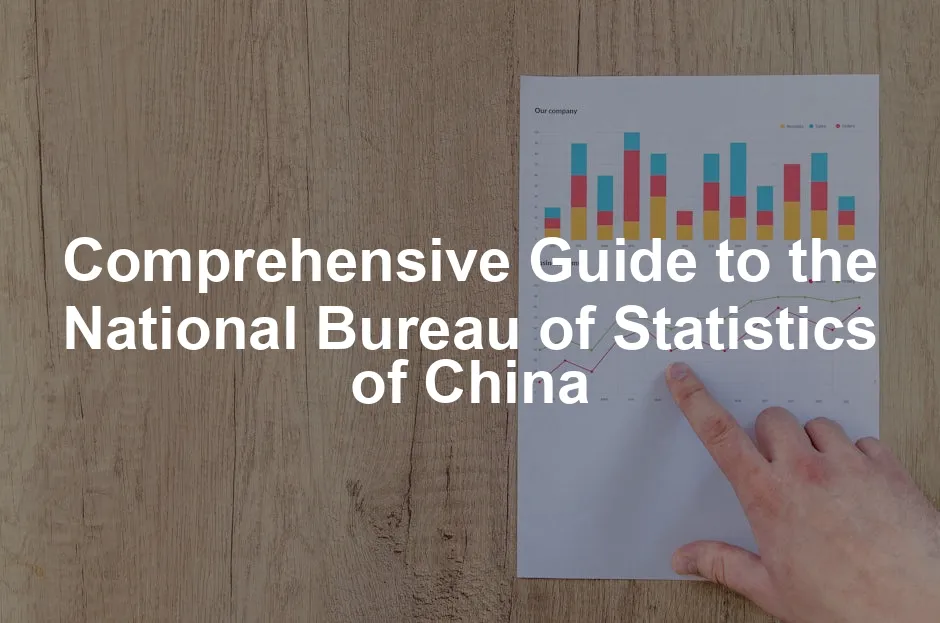Introduction
The National Bureau of Statistics (NBS) of China plays a pivotal role in shaping the nation’s economic narrative. Established under the State Council, this agency is the heartbeat of statistical data collection and analysis in China. Think of the NBS as the nation’s data librarian, meticulously cataloging facts and figures that help policymakers craft informed decisions. Without this crucial body, governing would be like trying to navigate a maze blindfolded.
The purpose of this article is to offer a thorough understanding of the NBS—what it does, how it operates, and its significant impact on statistical practices within China and beyond. By diving into its history, functions, and recent developments, we aim to provide a comprehensive resource for anyone interested in the statistical backbone of one of the world’s largest economies.
The NBS doesn’t just serve China; it is a vital player in the international statistics arena. Through data sharing and collaborations with global organizations, the NBS helps enhance the reliability and accuracy of statistics worldwide. This cooperation is essential for understanding global trends and fostering international economic relationships. So, whether you’re a researcher, a student, or just a data enthusiast, grasping the role of the NBS is key to comprehending China’s economic landscape.
If you’re looking to dive deeper into the world of statistics, you might want to check out the Statistical Analysis Handbook. It’s a fantastic resource that demystifies statistical concepts and provides practical applications for your research needs!
To learn more about the NBS and its operations, check out this comprehensive guide: kenya national bureau of statistics.
History and Establishment of the NBS
Early Years and Establishment
The National Bureau of Statistics was founded on August 7, 1952, during a time when China was undergoing significant transformation post-revolution. The need for a centralized statistical body became clear as the nation sought to rebuild and modernize its economy. Before the NBS, statistical efforts were decentralized and often inconsistent, leading to unreliable data that hampered effective governance. Establishing the NBS aimed to unify these efforts, ensuring that decisions were based on accurate and comprehensive information.
The NBS’s formation was a response to the pressing need for reliable data to support economic planning and development. Imagine trying to build a house without a blueprint; that was the scenario before the NBS came into play. With its establishment, China gained a dedicated team focused on gathering, analyzing, and disseminating vital statistics.
If you’re curious about how to visualize data effectively, consider investing in Data Visualization Software. These tools can help you turn raw statistics into stunning visuals that make your findings pop!
Evolution Over the Years
Since its founding, the NBS has evolved significantly. Over the decades, it has undergone various reforms to adapt to the country’s changing needs. In the early years, the agency focused primarily on basic economic data collection. However, as China’s economy grew, so did the complexity and scope of the NBS’s work.
Key milestones include the introduction of national censuses and comprehensive socio-economic surveys, which have become critical in shaping policy. The leadership of notable directors, such as Kang Yi, who has served since March 2022, has also influenced the agency’s direction. Under Kang’s guidance, the NBS has embraced modernization, incorporating technology to enhance data collection and analysis.
For those looking to understand the intricacies of data modeling, I highly recommend The Data Warehouse Toolkit: The Definitive Guide to Dimensional Modeling. It’s like having a roadmap to navigate the data landscape!
The NBS today stands as a robust institution, managing a wealth of data that informs China’s economic strategies and governance. Its journey reflects the broader narrative of China’s development, showcasing how vital statistical practices have facilitated informed decision-making and planning.

Structure and Organization
Organizational Hierarchy
The National Bureau of Statistics (NBS) boasts a structured hierarchy that ensures efficient management and operation. At the top of this structure sits the Commissioner, currently Kang Yi, who has been steering the agency since March 2022. Supporting him are several Deputy Commissioners, each responsible for various aspects of statistical governance. The NBS is divided into 12 functional departments, each playing a distinct role in the agency’s mission.
For instance, the Department of International Cooperation handles global statistical partnerships, ensuring that China’s data aligns with international standards. Meanwhile, the Department of Economic Statistics focuses on collecting and analyzing economic data crucial for national planning. Another vital department is the Department of Population, Social, and Science Statistics, which gathers demographic and social data to inform public policy.
While you’re exploring these departments, consider enhancing your research with tools like Excel Data Analysis: Your visual blueprint for analyzing data, charts, and PivotTables. This book can help you master Excel for data analysis effortlessly!
The NBS also oversees 12 affiliated institutions and manages a network of 32 survey organizations across provinces. This decentralized approach allows local agencies to gather data that feeds into the national database, ensuring that statistical practices are consistent and reliable nationwide.
Picture this organization chart like a well-oiled machine. Each department and survey organization works in harmony, ensuring that every cog is turning efficiently to produce accurate statistics. It’s a complex but necessary system, much like a bustling kitchen where every chef knows their role, ensuring a delicious outcome.

Local and National Coordination
The NBS does not operate in isolation. It collaborates closely with local statistical agencies to maintain data consistency across the country. This partnership is crucial, especially when considering China’s vast geographical and demographic diversity. Local agencies serve as the eyes and ears of the NBS, collecting data that reflects the unique challenges and developments within their regions.
To facilitate this coordination, the NBS has established a robust network of survey organizations throughout the provinces. These organizations conduct surveys and gather data that contribute to national statistics. The collaboration ensures that local insights are harmonized with national priorities, creating a comprehensive picture of China’s socio-economic landscape.
If you’re interested in the economic indicators that reflect this landscape, make sure to check out the Economic Indicator Tracker. It’s a handy tool to keep your finger on the economic pulse!
Imagine trying to bake a cake without knowing what ingredients your local bakery uses. You’d end up with something completely different from what you intended. That’s why the NBS values local input; it’s this detailed information that enriches national statistics and provides a more accurate reflection of the country’s status.

Responsibilities and Functions
Key Responsibilities
The NBS operates under the framework established by the Statistics Law of the People’s Republic of China, which outlines its primary responsibilities. At the core of its mission is data collection, analysis, and publication. This involves gathering information from various sectors, analyzing it, and then disseminating the findings to stakeholders.
One of the NBS’s most significant roles is conducting major censuses and socio-economic surveys. These extensive data collection initiatives, such as the national population census, provide invaluable insights into demographic trends and economic conditions. The results not only inform government policy but also guide businesses and researchers in their decision-making processes.
Additionally, the NBS ensures that data is made accessible to the public. By publishing statistical communiqués and yearbooks, the agency fosters transparency and promotes informed discourse among stakeholders. Think of the NBS as a friendly librarian, ensuring that everyone has access to the books (or data) they need to learn and make decisions.
Moreover, the NBS monitors key economic indicators such as GDP, CPI, PPI, and PMI. These indicators are vital for assessing economic performance and guiding policy adjustments. By keeping a finger on the pulse of the economy, the NBS helps steer the nation toward sustainable growth.
If you want to improve your understanding of data analysis techniques, consider reading Data Science for Business: What You Need to Know about Data Mining and Data-Analytic Thinking. It’s a great guide for anyone looking to leverage data in their business decisions!
In summary, the NBS is much more than a data collector; it is a crucial player in shaping China’s economic strategy, ensuring that decisions are made based on solid statistical foundations. Each responsibility flows into the next, creating a cohesive network of data-driven insights that serve the nation’s interests.

Recent Updates and Releases
Latest Publications
The National Bureau of Statistics (NBS) of China has been quite busy lately, releasing several key publications that help paint a clearer picture of the economic landscape. One of the most notable recent releases is the Market Prices of Important Means of Production in Circulation, published on September 2, 2024. This document provides vital information on price trends for essential industrial inputs and is crucial for businesses and policymakers alike.
Another significant release is the Purchasing Managers’ Index (PMI) for September 2024, which came out on October 1, 2024. The PMI is a vital economic indicator that reflects the health of the manufacturing and service sectors. A higher PMI indicates expansion, while a lower figure suggests contraction. These numbers greatly influence economic forecasts and investment decisions.
Furthermore, the NBS also published data on the Profit of Industrial Enterprises Above Designated Size for January to August 2024 on September 28, 2024. This report provides insights into the profitability trends within major industries, serving as an essential tool for analysts and investors looking to gauge the economic climate.
These releases are more than just numbers; they are essential tools for understanding economic dynamics. For instance, if the PMI shows a decline, businesses may reconsider inventory levels, while an increase in industrial profits could signal a potential hiring spree.

Economic Impact and Decision-Making
The implications of these releases extend beyond mere observation. They play a pivotal role in economic analysis and decision-making. Policymakers use this data to craft strategies and adjust economic policies. Investors rely on these insights to make informed decisions regarding stocks and market engagement.
For instance, if the NBS reports rising production costs, companies may need to adjust pricing strategies or find efficiencies to maintain margins. Conversely, a strong PMI can lead companies to invest more in production capabilities, anticipating increased demand.
Understanding these publications is critical for anyone involved in China’s economic landscape. They not only provide a snapshot of the current state but also set the stage for future trends and actions.

International Cooperation
The NBS also actively engages in international cooperation, demonstrating its commitment to global statistical standards. Recently, Commissioner Kang Yi met with the United Nations Statistics Division delegation on April 22, 2024. Such meetings are essential for fostering relationships and sharing best practices in statistical methodologies.
In addition to such high-level meetings, the NBS participates in various international workshops. Upcoming events include seminars on remote sensing in agriculture statistics and workshops focused on the implementation of the National Quality Assurance Framework (NQAF). These collaborative efforts ensure that China’s statistical practices align with global standards, improving the overall quality and reliability of data.
Such international engagements not only enhance the credibility of the NBS but also contribute to a more interconnected global statistical community. Through these efforts, the NBS showcases its commitment to transparency and accuracy, vital for informed decision-making on both national and international stages.
In summary, the NBS’s recent publications and international collaborations reflect its crucial role in shaping China’s economic landscape. The data it provides serves as a foundation for informed decisions, impacting everything from corporate strategies to international economic policies.

Major Economic Indicators
The National Bureau of Statistics (NBS) publishes a variety of economic indicators that serve as a compass for understanding China’s economic health. These key indicators guide policymakers, businesses, and analysts in their decision-making processes.
GDP: Gross Domestic Product (GDP) measures the total value of goods and services produced within a country. It’s like the economic report card for a nation. A rising GDP indicates a thriving economy, while a decline can signal trouble. For China, GDP is a critical measure, reflecting the rapid growth and development that has taken place over the last few decades. It helps in assessing the effectiveness of economic policies and planning for future growth.
CPI: The Consumer Price Index (CPI) tracks the average change over time in the prices paid by consumers for goods and services. It is a vital tool for understanding inflation. A rising CPI suggests that the cost of living is increasing, which can erode purchasing power. For everyday folks in China, monitoring CPI is essential, as it directly impacts their wallet. If prices rise too quickly, it can lead to economic unrest, making CPI a key indicator for stability.
PPI: The Producer Price Index (PPI) measures the average changes in selling prices received by domestic producers for their output. This index offers insights into the production side of the economy. A rising PPI can indicate that producers are facing higher costs, which may eventually trickle down to consumers. In China, monitoring the PPI helps track the health of various industries and predict future inflation trends.
PMI: The Purchasing Managers’ Index (PMI) provides insights into the manufacturing and service sectors. It gauges the economic health of these industries through surveys of purchasing managers. A PMI above 50 indicates expansion, while below 50 suggests contraction. For China, the PMI is a crucial indicator, reflecting sentiment and activity levels in the economy. Businesses and investors closely watch PMI data to anticipate changes in economic trends.
To complement your understanding of these economic indicators, you might find The Economist Book of Numbers: The Formula for Global Economic Success a great read! It provides context and analysis that can elevate your understanding of economic data.

Accessing Data and Resources
Online Platforms and Publications
Accessing statistical data from the National Bureau of Statistics (NBS) is easier than ever. The NBS website, www.stats.gov.cn, serves as the primary portal for all statistical information. Here, users can find a treasure trove of data, including economic indicators, demographic statistics, and sector-specific reports. It’s like a goldmine for data enthusiasts and researchers!
The National Data Repository is another impressive resource. It houses a vast array of datasets, including historical data and recent releases. Researchers can dive into comprehensive datasets from various economic censuses and national surveys. Everything is organized neatly, making it easy for users to find what they need.
For those in academia or business, there are additional resources available. The NBS provides Statistical Studios, which offer tools for data analysis. Users can request specific data through data request forms, making it a breeze to access tailored information. This service is invaluable for researchers looking to support their work with robust data.

If you’re interested in a guide that can streamline your data analysis process, consider exploring The Data Science Handbook. It’s an excellent resource that provides practical insights for data-driven decision-making.
User Guides and Tools
Navigating the NBS website is user-friendly, thanks to the guides and tools available. The site features tutorials and FAQs to help first-time visitors understand how to access and interpret data. This is especially helpful for those who might feel overwhelmed by the sheer volume of statistics.
Moreover, the NBS emphasizes data confidentiality. When accessing sensitive information, ethical considerations are paramount. The agency ensures that data usage complies with relevant laws and maintains the privacy of individuals. This commitment to confidentiality builds trust with the public and encourages responsible data sharing.
In summary, the NBS not only provides vital statistical information but also offers various tools and resources to help users engage with the data meaningfully. Whether you’re a researcher, student, or just a curious mind, the NBS is your go-to source for understanding China’s statistical landscape.

FAQs
What is the National Bureau of Statistics of China?
The National Bureau of Statistics (NBS) is China’s primary statistical agency, responsible for collecting, analyzing, and publishing data related to the nation’s economy and society.
How can I access data from the NBS?
You can access data through the NBS website, where a wealth of resources is available, including statistical studios and data request forms tailored to meet specific needs.
What are the key functions of the NBS?
The NBS’s main functions include conducting major censuses, releasing economic data, and ensuring the accuracy and reliability of statistics across various sectors.
Why is the NBS important for international statistics?
The NBS plays a crucial role in global statistics by sharing data and collaborating with international organizations, thus enhancing the reliability and accuracy of global statistical practices.
How often does the NBS release economic data?
The NBS releases economic data regularly, with frequent updates on key indicators such as GDP, CPI, PPI, and PMI, helping users stay informed about the economic landscape in China.
Please let us know what you think about our content by leaving a comment down below!
Thank you for reading till here 🙂
All images from Pexels




